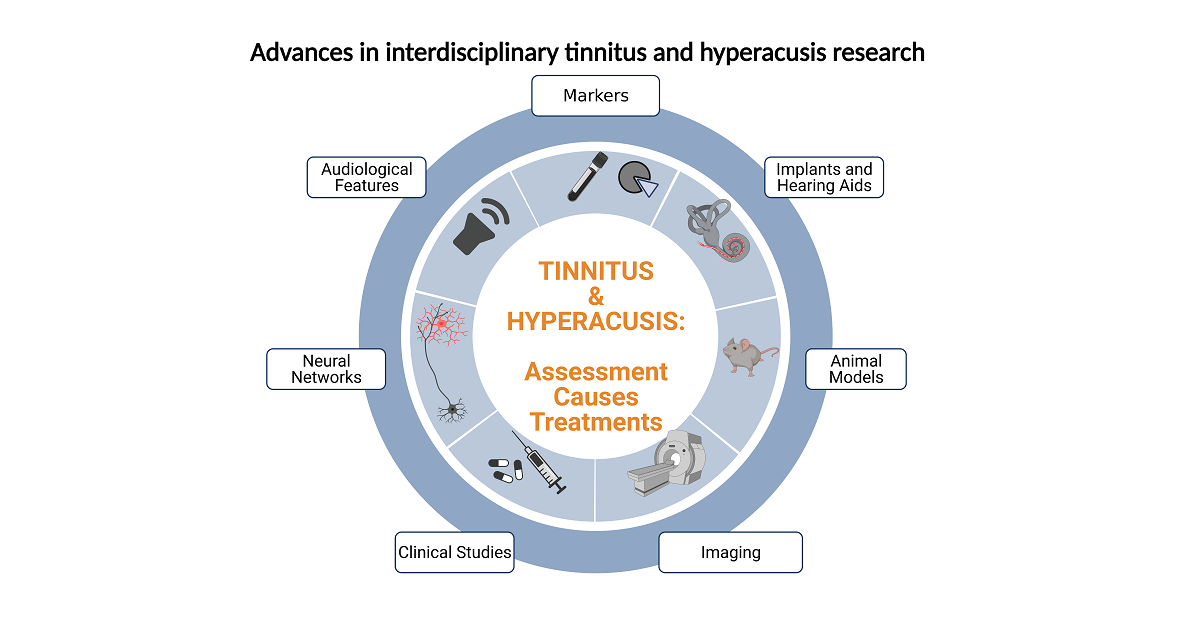Advances in Interdisciplinary Tinnitus and Hyperacusis Research
A special issue of Brain Sciences (ISSN 2076-3425). This special issue belongs to the section "Neuro-otology and Neuro-ophthalmology".
Deadline for manuscript submissions: closed (27 September 2022) | Viewed by 15720

Special Issue Editors
Interests: inner ear biology and physiology; age-related auditory and vestibular decline; patho-physiology of tinnitus; comparative auditory function
Interests: hearing research; inner ear immunology; ototoxicity
Special Issues, Collections and Topics in MDPI journals
Interests: tinnitus; brain imaging; otoacoustic emissions
Interests: EEG; rTMS; MRI; functional MRI; voxel-based morphometry; surface-based morphometry; higher-order diffusion-weighted imaging; resting-state fMRI analyses
Special Issues, Collections and Topics in MDPI journals
Interests: audiology; auditory perception; auditory neuroscience; tinnitus; hyperacusis; misophonia
Interests: neuroscience; neurophysiology; learning; neurobiology; physiology; neurobiology and brain physiology; audiology; hearing disorders; ear; brain
Special Issues, Collections and Topics in MDPI journals
Special Issue Information
Dear Colleagues,
Tinnitus, or “ringing” in the ears, is a widespread and potentially devastating condition. People with tinnitus continuously hear a penetrating phantom sound in the absence of actual sound. Tinnitus can be enormously debilitating and leads to difficulty concentrating, lack of sleep, anxiety, and depression. Even mild forms of tinnitus reduce productivity due to hearing and concentrating difficulties at work, or relaxing difficulties during leisure time. Tinnitus is often linked to hearing loss and hyperacusis, an exaggerated response (from annoyance to fear and pain) to ordinary sounds in the environment that are tolerated by others without hyperacusis. To cure tinnitus and better understand the links between tinnitus, hearing loss, and hyperacusis, TIN-ACT, a European consortium (https://www.tinact.eu/), brings together researchers, clinicians, and industrial partners to bridge the gap between basic research, applied clinical research, and product development.
The concept for this Special Issue originated from the Coordinator and Investigators of the European Union-funded project—the Research School for Tinnitus Assessment, Causes and Treatments (TIN-ACT). TIN-ACT supports the training of 15 early career researchers (https://www.tinact.eu/ and https://cordis.europa.eu/project/id/764604). In addition to the Special Issue Editors, the following supervisors/beneficiaries also provide expertise as Special Issue Affiliate Guest Editors:
Prof. Dr. Birgit Mazurek (Charite – Universitaetsmedizin Berlin)
Dr. Konstantin Tziridis (Universitatsklinikum Erlangen)
Dr. Laurent Pezard (Centre National de la Recherche Scientifique)
Prof. Dr. Dorothee Auer (University of Nottingham)
Prof. Dr. Michael Akeroyd (University of Nottingham)
Prof. Dr. Katrin Krumbholz (University of Nottingham)
Dr. James Harte (Oticon A/S)
Dr. Sueli Caporali (Widex A/S)
Dr. Filiep Vanpoucke (Cochlear Research and Development Limited)
This Special Issue will bring together research from the TIN-ACT consortium and its collaborators and bring attention to the interdisciplinary research needed to investigate tinnitus and develop treatments. Potential topics include but are not limited to:
- Clinical assessment of tinnitus and hyperacusis;
- The role of central gain in tinnitus and hyperacusis;
- Neural markers of tinnitus;
- Brain and brainstem imaging to investigate tinnitus and hyperacusis;
- The role of stress in tinnitus;
- Genetic mechanisms underlying tinnitus;
- Hearing aids and cochlear implants to improve tinnitus.
Dr. Sonja J. Pyott
Prof. Dr. Agnieszka Szczepek
Prof. Dr. Pim van Dijk
Dr. Elouise Koops
Dr. Arnaud Jean Noreña
Prof. Dr. Holger Schulze
Guest Editors
Manuscript Submission Information
Manuscripts should be submitted online at www.mdpi.com by registering and logging in to this website. Once you are registered, click here to go to the submission form. Manuscripts can be submitted until the deadline. All submissions that pass pre-check are peer-reviewed. Accepted papers will be published continuously in the journal (as soon as accepted) and will be listed together on the special issue website. Research articles, review articles as well as short communications are invited. For planned papers, a title and short abstract (about 100 words) can be sent to the Editorial Office for announcement on this website.
Submitted manuscripts should not have been published previously, nor be under consideration for publication elsewhere (except conference proceedings papers). All manuscripts are thoroughly refereed through a single-blind peer-review process. A guide for authors and other relevant information for submission of manuscripts is available on the Instructions for Authors page. Brain Sciences is an international peer-reviewed open access monthly journal published by MDPI.
Please visit the Instructions for Authors page before submitting a manuscript. The Article Processing Charge (APC) for publication in this open access journal is 2200 CHF (Swiss Francs). Submitted papers should be well formatted and use good English. Authors may use MDPI's English editing service prior to publication or during author revisions.
Keywords
- tinnitus
- hyperacusis
- hearing loss
- markers/biomarkers
- tinnitus therapy
- sound therapy
- stress and auditory system
Benefits of Publishing in a Special Issue
- Ease of navigation: Grouping papers by topic helps scholars navigate broad scope journals more efficiently.
- Greater discoverability: Special Issues support the reach and impact of scientific research. Articles in Special Issues are more discoverable and cited more frequently.
- Expansion of research network: Special Issues facilitate connections among authors, fostering scientific collaborations.
- External promotion: Articles in Special Issues are often promoted through the journal's social media, increasing their visibility.
- e-Book format: Special Issues with more than 10 articles can be published as dedicated e-books, ensuring wide and rapid dissemination.
Further information on MDPI's Special Issue polices can be found here.










